Mongolian shrimp
This Mongolian shrimp recipe is a quick and delicious Taiwanese takeout meal powered by its signature aromatics: garlic, ginger, and green onions. A simple sauce adds sweetness, umami, and brightness. This recipe doesn’t use batter, so it’s fast, easy, and low in carbs.
Follow my simple tip on how to velvet shrimp just like the restaurants for snappy and tender shrimp every time. For more stir-fries like this one, try my Paleo Mongolian beef or Mongolian chicken.
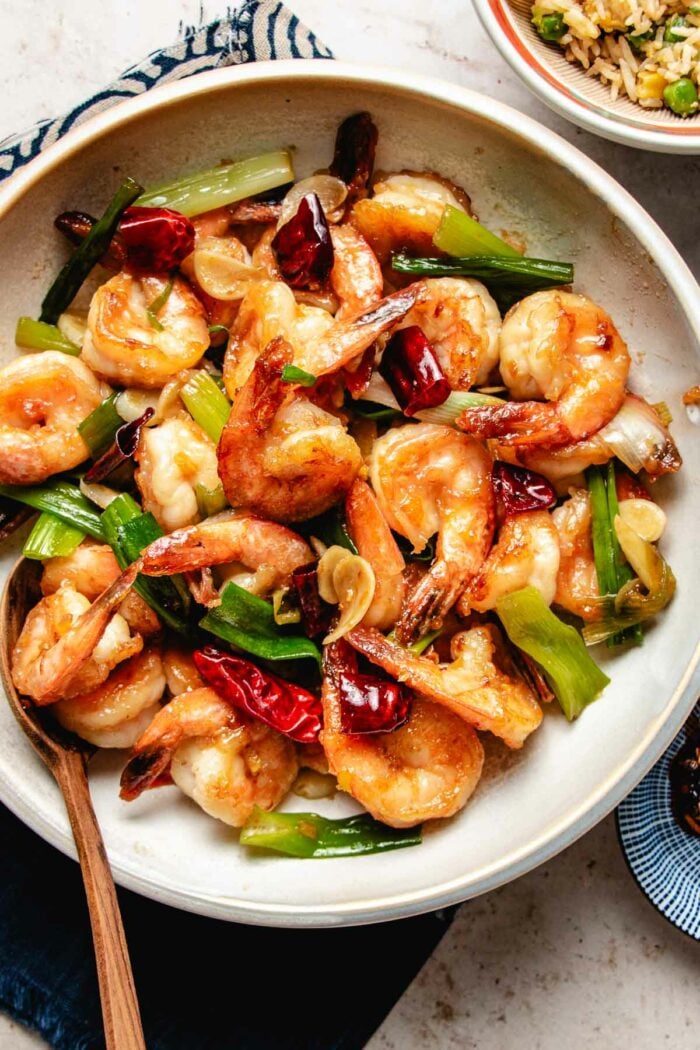
What is Mongolian shrimp?
Mongolian-style shrimp is a Taiwanese stir-fry dish featuring tender shrimp in a thick savory sauce with loads of aromatics.
The shrimp are usually marinated (velveted) and then seared in a hot wok to create a delicious crisp texture. The signature flavor comes from green onions, garlic, ginger, and chili. The dish is tossed together with a savory sauce containing soy sauce, rice wine, a touch of sugar, and starch.
In authentic Mongolian stir-fries, the sauce takes a backseat to the aromatics and main protein ingredient. For instance, Mongolian beef doesn’t even require a sauce — its flavor comes from the beef itself and the aromatics cooked in a hot wok.
You’ll learn how to make an authentic Mongolian stir fry, plus tips on how to tenderize shrimp and how to make shrimp crunchy and springy, just like the restaurants’.
Ingredients
This Mongolian-style shrimp stir-fry is a simple dish that comes together quickly using Chinese pantry staples and flavorful aromatics for great depth of flavor. Here are the ingredients you’ll need to prep raw shrimp, stir-fry aromatics, and tie it all together with a simple, balanced sauce.
To velvet shrimp:

- Shrimp: Peel and devein the shrimp or use peeled and deveined shrimp to save time. You can have the tail on or off. Use medium shrimp (about 20-30 shrimp per pound), which are sweet, tender, and snappy.
- Cold water and baking soda: Briefly soak shrimp in baking soda to improve the texture, making them less slimy. It’s the secret to snappy shrimp in Chinese stir-fries. (Optional step)
- Tapioca starch: Or potato starch, arrowroot starch, or cornstarch. After soaking shrimp in baking soda, pat dry and coat with starch to seal in moisture for crispy yet juicy shrimp.
For the stir-fry:

- Garlic, ginger, and scallions: These aromatic ingredients are what give this dish its defining flavor and are the essence of what a Mongolian stir-fry is.
- Chinese dry red chili peppers: First cut them open and shake out the seeds. They give the dish a pop of color and a hint of smoky spice.
- Avocado oil: We use a neutral-flavored oil so as to not interfere with the flavor of the aromatics. Avocado oil is also great for high-heat cooking.
- Coarse sea salt
- Chinese rice wine (optional): We use rice wine to deglaze the wok when cooking a stir-fry. Mirin is a gluten-free alternative to Chinese rice wine.
For the Mongolian sauce:
- Coconut aminos: Alternatively, you can use ½ tbsp low-sodium soy sauce or tamari mixed with a touch of coconut brown sugar.
- Chinese rice wine or gluten-free mirin: Rice wine adds a subtle sweetness and mellow tangy flavor to the sauce to brighten the dish. I don’t recommend substituting other types of vinegar, as they will be too sharp and overpower the delicate shrimp flavor.
- Peach jam: I use peach jam to sweeten the sauce and thicken it without adding starch. Apricot jam or orange jam are also good options. Or use coconut brown sugar or honey.
Substitutions and variations
- Chinese dry red chili peppers: You can use a touch of red pepper flakes or Korean gochugaru.
- Sweetener: You can also use honey or coconut brown sugar to sweeten the Mongolian sauce.
- Sauce: Give your sauce mixture some added depth of flavor and thickness by adding a splash of my gluten free hoisin sauce or vegan oyster sauce.
- Veggies: For a fuller meal, add your favorite vegetables like bell pepper, broccoli florets, or yellow onion.
- Garnish: Toasted white sesame seeds add some crunch and nuttiness to the shrimp.
How to make the dish
Now that you have the ingredients for this Asian shrimp recipe, let’s walk through the easy steps to making this dish. We’ll learn how to prepare shrimp to make it tender by brining shrimp in baking soda, plus some helpful tips for cooking shrimp in a wok.

- [Optional] Shrimp and baking soda bath to make shrimp crunchy and snappy. Add shrimp to a large bowl with cold water and baking soda. Gently massage and chill in the fridge for at least 30 minutes and up to overnight. Rinse the shrimp a few times then pat dry.
- [Optional] Butterfly cut the shrimp on the back side by making a shallow slit, using a small pairing knife. In a large bowl, toss the shrimp with starch and coat it well on all sides.
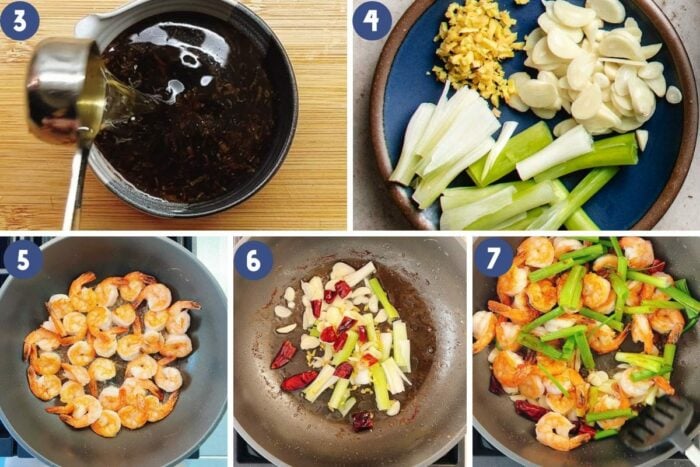
- Prep the garlic, ginger, and scallions. Dice the scallions into 1.5-inch sections and separate the white and green parts. If using Chinese dry red chili peppers, cut them open and discard the seeds.
- Mix the Mongolian sauce ingredients of coconut aminos, rice vinegar, and peach jam in a small bowl.
- Pan-fry the shrimp. In a large, preheated non-stick skillet heat oil over medium heat until it feels hot. Add the shrimp and in a single layer. Cook the shrimp over medium-high heat for 2 minutes on the first side and 2 minutes on the flip side. Remove from the pan and set aside.
- Cook the aromatics. In the same large wok, add the remaining half tablespoon of oil. Saute the garlic, ginger, white scallion parts, and chili peppers with a pinch of salt over medium heat.
- Toss in the sauce. Return the shrimp to the pan. Pour in the sauce. Heat on medium-high. Add a small splash of Chinese wine, if using. Toss for 10 seconds then turn off the heat. Transfer the shrimp to a serving plate. Serve hot with rice.
Why velvet shrimp
Velveting is a popular preparation technique used especially when cooking shrimp for Chinese dishes. The process involves soaking the shrimp in cold water and baking soda. Sometimes, salt and sugar are also added to the shrimp marinade for stir fry.
- Method 1: Sprinkle baking soda on shrimp and soak in a cold water solution for at least 30 minutes or overnight in the refrigerator. This velveting process helps to draw out any impurities from the shrimp and improves texture.
- Method 2: Another common method is to marinate the shrimp in a mix of cornstarch, egg whites, oil, and seasonings. This velveting shrimp process seals in moisture, resulting in tender yet crisp shrimp. My Whole30 Bang Bang shrimp uses this method.
The best method to use when marinating shrimp for stir fry depends on the particular dish, as the end result will be different with each technique.
In short, velveting improves the flavor, texture, and presentation of shrimp. This technique works particularly well when the shrimp is less-than-ideal fresh. Velveting is also used for chicken and beef. Click here for how to velvet chicken and the best beef stir fry marinade.
How to make ahead, store, and reheat
To make ahead, you can do the preparation of shrimp and aromatics the night before cooking. Once cooked, this dish is best eaten within a couple of days for maximum freshness.
- Make-ahead: Velvet the shrimp and store the prepared shrimp in the fridge overnight. Prepare the aromatics and pack them in an airtight container in the refrigerator.
- Storage: After cooking, it’s best to finish leftovers in 2-3 days.
- Reheat: Loosely cover the bowl and microwave on medium for 1 minute. Stir and microwave for an additional 30 seconds.
What to serve it with
This flavorful shrimp stir-fry is perfect when served over simple steamed rice. Read about how to cook rice in an air fryer here or try my air fryer fried rice for extra flavor. Here are some of my favorite pairings to turn this stir-fry into a larger family-style meal.
- Vegetables: Combine it with this Chinese broccoli stir fry for a classic Chinese shrimp with broccoli dish. For added spice, pair it with this spicy cucumber salad.
- Noodles: Tired of plain rice? No problem! These garlic chili noodles or this 10-minute chili oil ramen are perfect flavorful additions to this stir fry.
Expert tips
- Pick shrimp size that works for the recipe. When making this dish, medium to large shrimp (around 20 pieces per pound) are ideal.
- Check shrimp for freshness. Choose shrimp that are firm and avoid any with an ammonia smell or mushy texture, as they are past their prime. Only use shrimp that seem fresh.
- Velvet the shrimp. If time allows, marinate the shrimp in a baking soda and cold water solution for at least 30 minutes. This will improve the texture and the shrimp will remain snappy and bouncy after cooked.
- Use a hot wok or pan. Preheat the pan well before adding the shrimp. It should feel fairly hot when placing your palm near the surface. You need high heat to sear the shrimp quickly and cook them perfectly.
- Don’t overcook. Shrimp cooks very fast. In a well-heated pan, about 2 minutes per side and 4 minutes total are all you need to sear the shrimp to opaque.
- Cook ingredients separately. Stir-fry aromatics separately before adding shrimp.
- More aromatics. Spring onions, ginger, and chili provide the core flavor in Mongolian stir fry. The sauce simply enhances the natural flavors of the aromatics rather than being the main taste itself. It is the aromatic ingredients, not the sauce, that make a dish Mongolian in style.
FAQs
Mongolian shrimp Chinese stir-fry is made of shrimp marinated in baking soda, starch, garlic, ginger, scallions, dry red chilies, oil, rice vinegar, soy sauce, sugar, and optional rice wine. The key flavors come from aromatics like garlic, ginger, and scallions stir-fried in a hot wok to create an authentic Mongolian flavor. A savory sauce brings the dish together and coats the tender seared shrimp.
There are 2 methods to velvet shrimp: 1) Velveting shrimp coats peeled, deveined shrimp in a thin layer of cornstarch, egg white, oil, and seasonings, or 2) Marinate shrimp in a baking soda, water, salt, and sugar solution to improve the texture. Velveting seals in moisture and prevents rubbery texture when stir-frying at high heat. The coating gives shrimp a silky, juicy texture and allows better absorption of sauces and seasons. It results in tender yet crispy shrimp.
In a well-heated pan, the shrimp are pan-fried for 2 minutes per side, so 4 minutes total. They are cooked in a non-stick pan over medium to medium-high heat for 2 minutes on the first side, then flipped and cooked for another 2 minutes on the second side before being removed from the pan. The total shrimp cooking time is just 4 minutes to achieve perfect texture.
Shrimp is done cooking when it turns opaque and pinkish in color throughout. The flesh should feel firm yet springy when pressed, not mushy. Properly cooked shrimp will curl tightly forming a “C” shape. Overcooked shrimp becomes rubbery and chewy. For stir-fries, shrimp is best removed just before it is fully cooked through, as it will continue cooking off heat.
More Chinese shrimp stir-fry recipes
For more healthy recipes using shrimp, be sure to give these delicious Chinese seafood recipes a try too!
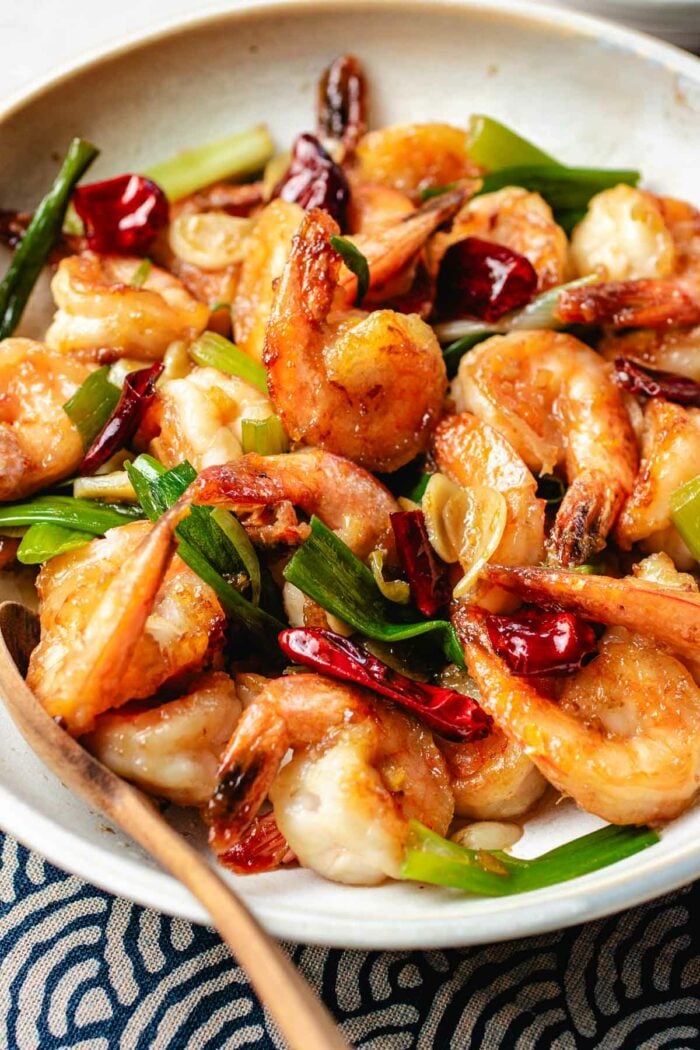

Mongolian shrimp recipe
Video
Ingredients
For the shrimp:
- 1 lb shrimp, 26-30 count, peeled and deveined
- 2 cup cold water
- 2 tsp baking soda
- 1.5 tbsp tapioca starch
For the stir-fry:
- 0.8 oz garlic cloves, thinly sliced, 5 large
- 0.2 oz ginger, finely chopped
- 3 bulb scallions, dice to 1.5-inch sections and separate white and green parts
- 4 whole Chinese dry red chili peppers, cut open to sections and seeds removed
- 1.5 tbsp avocado oil
- Pinch of coarse sea salt
- A splash Mirin, or Chinese rice wine, optional
For the Mongolian sauce:
- 1 tbsp coconut aminos
- 1 tsp rice vinegar
- 1 tsp peach jam, or aprioca, orange jam, coconut sugar
Instructions
[Optional] To velvet the shrimp (more crunchy and snappy):
- Soak the shrimp in a large bowl with cold water and baking soda. Gently message and chill the bowl in the fridge for at least 30 minutes and up to a night before. Discard the water and rinse the shrimp a few times then pat them dry.
[Optional] To butterfly the shrimp:
- Butterfly the shrimp on the back side by making a shallow slit, using a small pairing knife, In a large bowll, toss the shrimp with starch and coat it well on all sides.
- Thinly sliced the garlic, finely chop the ginger, and slice the green onions into 1.5-inch sections and separate the white and green parts. For Chinese dry red chili peppers, if using, use kitchen shears to cut them open into 3 sections and shake out and discard the seeds. Set aside the Mongolian sauce in a small bowl.
- Preheat a large non-stick saute pan over medium heat until it feels hot then add 1 tbsp oil. Add the shrimp and spread them out into a single layer. A slight overlap is okay. Pan fry the shrimp over medium to medium-high heat for 2 minutes on the first side and 2 minutes on the flip side. Transfer them out and set aside.
- Use the same pan, add the remaining half tablespoon of oil. Saute the garlic, ginger, white scallion parts, and chili peppers with a pinch of salt over medium heat for 10 seconds.
- Return the shrimp to the pan. Pour in the sauce. Turn heat up to medium-high. Add a small splash of Chinese wine, if using. Give everything a quick toss for about 10 seconds then turn off the heat.
- Transfer the shrimp to a serving plate. Serve hot with rice.
Notes
- In authentic Mongolian stir-fries, the sauce takes a backseat to the aromatics and main ingredient. For instance, Mongolian beef doesn’t even require a sauce – its flavor comes from the marinated and velveted beef itself and the aromatics cooked in a hot wok. The real essence of Mongolian flavor is in the aromatic ingredients like spring onions, ginger, and chili, quickly stir-fried over high heat.
- When making Mongolian shrimp, focus on achieving a perfect snappy, springy texture for the shrimp. Follow the steps on how to properly velvet the shrimp to get that signature crunch along with the authentic Mongolian wok-fried flavor. The sauce simply enhances the shrimp and aromatics rather than overpowering them.
- If you are short on time, skip soaking the shrimp in baking soda water and butterfly the shrimp. Simply pat the shrimp dry, then coat with starch before pan frying.
Nutrition
Made a dish and love it? Please remember to rate the recipe and leave a comment in the comment section below! It helps my blog grow organically so I can continue sharing free and awesome content with you. Thank you!


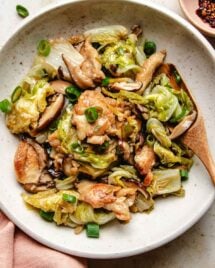

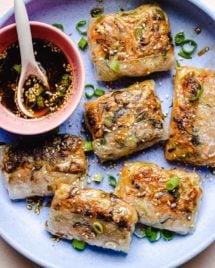
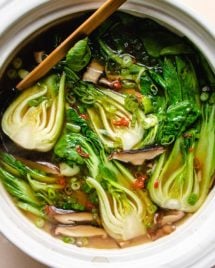



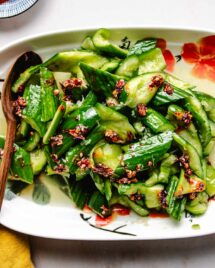
I love this recipe. So flavorful and simple. It’s on repeat in my house. Quick and easy week night dinner
Thanks so much, Jean.
I made this over the weekend for my mom and we both absolutely love this shrimp stir fry. The Mongolian sauce is perfectly balanced with a sweet and savory flavor just like what we had when we visited Hong Kong. This dish comes together quickly especially if you use shrimp that are already shelled and deveined. Healthy, flavorful, and so good. We paired it with a bowl of steamed rice and some cucumber salad on the side (she also has quite a few cucumber recipes on the blog). What a fantastic meal. Thank you!